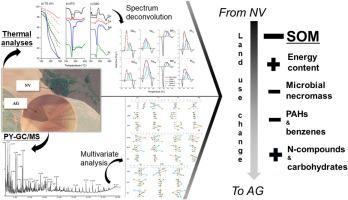Soil and Tillage Research ( IF 6.5 ) Pub Date : 2021-07-28 , DOI: 10.1016/j.still.2021.105156 Matheus Sampaio C. Barreto 1, 2 , Judith Schellekens 2 , Marlon Ramlogan 3 , Ashaki A. Rouff 3 , Evert J. Elzinga 3 , Pablo Vidal-Torrado 2 , Luis Reynaldo F. Alleoni 2

|
Soil organic matter (SOM) plays an important role not only for agriculture but also in the global carbon (C) balance with a potential to mitigate climate change. Land-use changes from native vegetation to intensive agricultural use enhance mineralization of SOM and thereby cause decreases in the amount of soil C. Association of SOM on soil minerals is highlighted as key stabilization mechanism of SOM. To examine the contribution of land-use change and soil mineralogy on soil C losses, soils with different soil mineralogy assemblage were studied from four areas in Brazil, all having sites with agriculture and nearby soils under native vegetation. We assessed SOM stability by thermogravimetric (TGA) and differential scanning calorimetry (DSC) and the molecular composition of functional soil C pools by pyrolysis gas chromatography/mass spectrometry (Py–GC/MS). On average, 33 % of soil C was lost in three sites after land-use change. Py-GC/MS indicates a dominance of reworked and/or microbial material (58–99 % N-containing products and carbohydrates), and low contribution from plant-derived products such as lignin phenols (from 0.1 to 7.7 %), and striking similarities in molecular composition between native vegetation and corresponding sites under agriculture. Thermal data indicate lower energy content in soils under native vegetation than agriculture, confirming microbial-derived SOM. The gibbsite content was positively correlated to N-containing products in both SOM extracted by alkaline solution (r2 = 0.60) and SOM residual after alkaline extraction (r2 = 0.82), while the kaolinite content showed a negative correlation with N-containing compounds (r2 = 0.72) and a positive one with carbohydrates (r2 = 0.48). Thus although SOM content highly decreased upon horticulture, both Py-GC/MS and thermal analyses indicate that SOM composition is mainly controlled by site instead of land-use, and the strong correlations with clay minerals suggest a mineralogical control on SOM composition.
中文翻译:

园艺对高度风化热带土壤土壤有机质性质的影响
土壤有机质 (SOM) 不仅对农业而且在全球碳 (C) 平衡中发挥着重要作用,具有减缓气候变化的潜力。从原生植被到集约化农业利用的土地利用变化增强了 SOM 的矿化,从而导致土壤 C 量减少。 SOM 与土壤矿物质的关联被强调为 SOM 的关键稳定机制。为了检查土地利用变化和土壤矿物学对土壤碳流失的贡献,对巴西四个地区具有不同土壤矿物学组合的土壤进行了研究,所有地区都有农业用地和附近原生植被下的土壤。我们通过热重 (TGA) 和差示扫描量热法 (DSC) 评估了 SOM 的稳定性,并通过热解气相色谱/质谱法 (Py-GC/MS) 评估了功能性土壤碳库的分子组成。平均而言,土地利用变化后三个地点的土壤碳损失了 33%。Py-GC/MS 表明返工和/或微生物材料(58-99% 含氮产品和碳水化合物)占主导地位,而植物衍生产品如木质素酚的贡献较低(0.1 至 7.7%),并且显着原生植被与农业相应地点之间分子组成的相似性。热数据表明原生植被下土壤的能量含量低于农业,证实了微生物来源的 SOM。2 = 0.60) 和碱提取后的 SOM 残留 (r 2 = 0.82),而高岭石含量与含氮化合物呈负相关 (r 2 = 0.72),与碳水化合物呈正相关 (r 2 = 0.48)。因此,尽管 SOM 含量在园艺后大幅下降,但 Py-GC/MS 和热分析均表明 SOM 组成主要受场地而不是土地利用控制,并且与粘土矿物的强相关性表明 SOM 组成受矿物学控制。


























 京公网安备 11010802027423号
京公网安备 11010802027423号